Languages
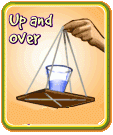
Contributed By: COSI
|
| Share This Experiment |
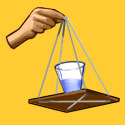 |
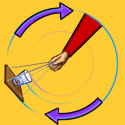 |
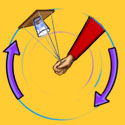 |
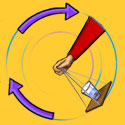 |
Experiment Category:
Objective:
Discover how you can whirl a cup of water over your head without spilling it.
What You Need:
- A strong piece of cardboard cut into a 6" square
- Hole punch
- Two 1 meter (3 foot) pieces of string
- A plastic cup
- Several pennies
- Water (if you do this outside)
- Create your Water Whirler!
- 1) Punch a hole about 1 cm (¼ inch) in from each corner of the cardboard.
- 2) Pull one piece of string up through one of these holes. Pull the opposite end of this string up through the diagonal corner of the cardboard. Do the same with the other piece of string in the remaining two holes. You will have formed an X with the string on the bottom of the cardboard base.
- 3) Place the cardboard base flat on the floor, and pull the four ends of the strings straight up until they are tight. Keep all four ends together, and make certain the base is straight. You will have formed a pyramid shape. Loop the ends together to form a knot.
To Do and Observe:
Hold on to the knot and make sure the Water Whirler is sitting flat. Place the plastic cup in the middle of the base. Place several pennies in the cup to give it some weight. (If you can work outside, fill the cup half-full with water instead of placing the pennies in it.) Try whirling the cup around and around. Try it over your head. Try making a figure eight with it. Does the cup stay in place? Why? What about its contents? When you stop this activity, do so slowly. Think about Newton's First Law of Motion - a body in motion tends to stay in motion, or a body at rest tends to stay at rest unless acted upon by an outside force. If you suddenly stop the Water Whirler, what will happen to the cup and water that are not attached to the base, but only resting on it?
What's Going On:
A moving object will keep going straight until a force acts upon it. A force that causes the acceleration needed to make an object move in a circular path is called centripetal force. Acceleration to a scientist can mean either a change in the speed of an object, or a change in the direction in which the object is traveling. In this case, the string attached to the base caused the centripetal force that kept the Water Whirler moving in a circular path. Can you think of a time when Newton's First Law of Motion affected you? Did you ever run your skateboard into a curb? What happened to your body? Did you ever run into something with your bike? What happened?
Parent/Teacher Tips:
If you're having trouble keeping the water in the cup, try to whirl from your elbow (not use your whole arm and whirl from your shoulder). As the radius of the circle gets longer, the faster you have to whirl to create enough centripetal force to keep the water in the cup. Challenge your children to come up with everyday real-life examples of Newton's First Law of Motion. For example, rounding a corner in a car pushes its occupants to the opposite side of the turn. The use of seat belts in the vehicle counters the effects of Newton's First Law. Ask them why they need to lean their bicycle into the direction of a turn to avoid falling over!
